We connected with some of the countless Rams bringing people together to repair and lift up their communities.
A Pro Runner Blows the Whistle on Abusive Training Culture
In 2013, at age 17, Mary Cain was one of the top runners in the world, the youngest U.S. athlete ever to compete on a World Championships team. But soon after joining Nike’s elite Oregon Project to train with head coach Alberto Salazar, her health and her promising pro career deteriorated.
Her coaches forced her to lose weight, which led to the loss of her period for three years and stress-related injuries, including five broken bones, Cain said.
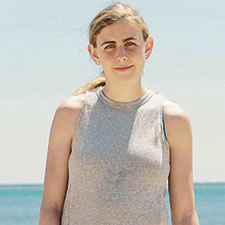
“You don’t go from losing weight to breaking bones in two days, right? There’s usually this long period of time where there’s this physical deterioration,” Cain said at Fordham’s ninth annual Sports Business Symposium, held virtually on March 25. “Throughout the day, I just was more prone to having silly things, like headaches, to just being more hungry, to being a little bit more irritated as a result, and to just being visibly fatigued.”
She began to dread the sport she had loved since fifth grade. Her physical, emotional, and mental health began to spiral downward. She developed an eating disorder and began to cut herself and have suicidal thoughts.
“What once had been something that came naturally to me, this beautiful experience … suddenly became a slog,” Cain said. “The longer that I was in this really circular system, the more my body broke down.”
Cain completed one year at the University of Portland while training with the Oregon Project before transferring to Fordham’s Gabelli School of Business, where she earned a bachelor’s degree in 2019. After moving to New York, she kept training with the Nike project until 2016.
In a November 2019 video piece for The New York Times, Cain said the all-male coaching staff, led by Salazar, did not include a certified sports psychologist or certified nutritionist, and that Salazar had tried to put her on birth control pills to lose weight and harmed her mental health by berating her and humiliating her in front of her fellow athletes.
“Women in sports are treated harsher when it comes to body image,” she said during the Fordham symposium in March. “And I believe the reason is mostly societal—the expectation to be a lighter weight is more attached to [women’s] looks and their meaning. And it’s this really toxic culture that I think permeates professional sports.”
After Cain’s story came out, many other women supported her claims, including Kara Goucher, an Olympic distance runner who had trained under the same Nike program. Salazar denied the allegations of abuse, but several weeks before Cain’s story was published, he received a four-year ban from the sport for doping violations, and Nike had already shut down the Oregon Project.
In January 2020, Nike completed an internal investigation of Cain’s allegations of abuse, and her story helped Nike identify initiatives to “do better in supporting female athletes,” including increasing the number of women coaches in sports and investing in scientific research into the impact of elite training on women and girls.
Today, Cain is the New York City community manager for Tracksmith, a running apparel company. She runs professionally as a member of USA Track & Field and continues to call for reforms, including having teams provide mental health counselors and sports psychologists who are separate from the coaching staff.
She said her goal in sharing her story is to make sure that no other athletes, particularly female athletes, have to go through the suffering she did.
“I hadn’t known that the situation was bad until somebody [told me], ‘That is bad. That shouldn’t happen to you.’ It’s normalized,” she said.
“I realized I didn’t want any other person out there to … be self-loathing, beat themselves up, and have this incredibly negative experience because they were under an emotionally abusive coach and almost didn’t know it.”
—Kelly Kultys, FCRH ’15
A Gun Violence Survivor Works to Heal Social Divisions
Lamont Young knows something about forgiveness and bridging interpersonal divides.
In 1993, he almost died after being shot seven times in the chest—point blank—by an acquaintance who was high on PCP. But he later found the strength to forgive his assailant, and in doing so, he was inspired to pursue a lifelong path of helping others.
That path eventually led him to the Graduate School of Education, where he earned a master’s degree in mental health counseling in 2018.
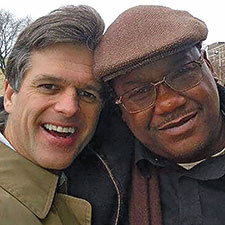
Then he made a career move that led to a personal transformation. He went to work with UNITE, a national initiative co-founded by Special Olympics Chairman Timothy Shriver that seeks to help Americans overcome divisions, and he gained a new perspective.
“I went in with this psychological approach to addressing the human condition and suffering caused by racism and discrimination. I had a burning desire to promote human dignity and shed light on segregation and dehumanization, but I was so caught up in my head trying to find ways to address this,” he said.
“Once I met with the UNITE team, I had a spiritual awakening. I started to address them not from my mind or from my heart, but from my spiritual background. It was transformative to understand that in spite of it all, we have to love, we still have to forgive.”
Young and his mother, Glenda, are featured in The Call to Unite: Voices of Hope and Awakening (Penguin Life/The Open Field), published in March. The book contains an interview with them conducted by Shriver, who knew Young from a young men’s group he once led in New Haven, Connecticut.
“A mother who raises a son who can take on the hardscrabble and often fatal streets of New Haven and not only come through it but come through it with forgiveness and an open heart—that’s a mother I want to learn from,” said Shriver, who spoke about the power of personal transformation at Fordham’s 2019 commencement ceremony, where he received an honorary doctorate.
Shriver said the book’s common thread is that when we treat ourselves and others with dignity, we unlock potential, even during disagreements.
“This is hard emotional, spiritual, political work,” he said. “If you want a quick solution, this is the wrong place. But if you want the best solution, there’s only one way, and that’s to unite.”
In addition to conducting research on dignity and respect for UNITE, Young works with people experiencing homelessness in New Haven at Columbus House and provides psychotherapy at Reliant Behavioral Health Community Service.
And he has learned about some new dimensions of forgiveness. “You can transgress against yourself by not forgiving yourself for some of the things that you haven’t done or some of the time you haven’t spent with your loved ones before they left this Earth,” he said. “I found that very powerful, to understand how to love and forgive yourself in the midst of turmoil and grief in order to free yourself.”
—Patrick Verel, GSAS ’15
A Nonprofit Leader Rescues Food Waste to Relieve Hunger, Promote Community
As the president and CEO of Community Solidarity, Jon Stepanian runs the largest vegetarian hunger relief program in the country. It’s a nonprofit he hopes doesn’t exist in a generation or two.
“When we started, we wanted to build a structure where we could theoretically put ourselves out of business in the communities where we operate,” Stepanian said. “We want to make sure that there’s going to be no need for us in 30 to 40 years if the community itself can take care of these needs.”
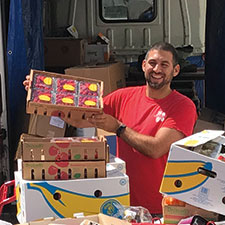
Based on Long Island, Community Solidarity rescues food from being wasted at supermarkets and farms and distributes it to people at food shares across four locations on Long Island and one in Bedford-Stuyvesant, Brooklyn. Each area, he says, is at risk of being a “food desert,” where fresh, nutritious, affordable food is hard to find.
“We rescue food waste because it’s common sense—it’s cheap to do it. But on a more philosophical level, on a more economic level, this is why people in our communities are struggling. We see it as a fundamental problem in our system that’s making people in our community poor and hurting people overseas and also destroying our environment by producing large quantities of stuff that we don’t need,” he said.
“We’re trying to rescue a small portion of that waste and repurpose it for something good, like feeding our neighbors, but we’re also trying to expose the problem.”
Stepanian knew he wanted to focus on helping local communities after graduating from Fordham. As an undergraduate, he studied history and political science—and an internship at the United Nations and a stint working at the American Civil Liberties Union gave him perspective on working within the intergovernmental and nonprofit sectors. Shortly after college, he and his friends started a Food Not Bombs chapter on Long Island, occasionally setting up a food distribution table on weekends.
Before long, he realized he needed to create a more sustainable structure to keep the food distribution going. Community Solidarity, with its 501(c)3 nonprofit status, was born out of this realization, although Stepanian said that a nonhierarchical structure was important from the outset.
“When we decided to become a nonprofit, we said we wanted no lines of demarcation between who can volunteer and who can get food,” he said. “We wanted to make it so you wouldn’t be able to tell if someone’s volunteering or in need or both.”
In a 2018 TEDxNYU talk, Stepanian talked about what he called “the myth of scarcity,” and how a communal response can not only address hunger but also help to create a deeper sense of belonging among neighbors.
“We’re also trying to raise awareness by saying that we will, in 10 years, be the largest hunger relief organization in the country, and we’re doing it for a thousandth of the price that the food banks are doing it, all because of this waste,” Stepanian said.
“This is how abundant that system of waste is. We want to make it eye-opening for people.”
—Adam Kaufman, FCLC ’08
A Familiar Face Offers Financial Literacy Training to Fellow Women of Color
As a young woman growing up in Brooklyn, Felicia Gomes-Gregory knew she wanted two things: to attend Fordham University and to work as a computer scientist. She achieved both.
But now, more than 30 years later, Gomes-Gregory is focused on something new, which she calls her passion project: Heels and Higher Achievement, a nonprofit that empowers women and people of color by helping them learn about finance.
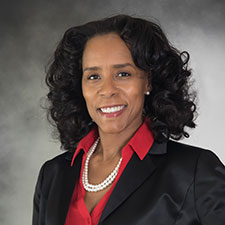
Her path to forming the nonprofit started in 2016, when she received what she calls a blessing in disguise. After a decades-long career at various financial firms in New York City, she was laid off from Neuberger Berman, an employee-owned investment management firm.
She asked herself what she would do next. “In my heart, I’ve always wanted to … get more women involved in technology or finance, and especially women of color, because I never saw anybody that looked like me—or not enough of it,” Gomes-Gregory said.
She kicked off Heels and Higher Achievement (HHA) in 2018, determined to make financial literacy fun while giving a voice to those in her community who are empowering young women in tech, finance, STEM, media, or “whatever it is that they want to do,” she said. “I wanted to create a forum so that people can speak, but mainly speak about financial education.”
That first year, she conducted in-person workshops at schools, churches, and “anywhere anyone would hear me,” Gomes-Gregory said. She’d speak about basic financial literacy concepts and invite people to schedule a complimentary financial review—a kind of “GPS of your money,” she said, “to make sure you can stop working for money at some point and [let]money work for you.”
She also launched an ambassador program to give young girls opportunities to network with professionals and serve their communities through volunteer work. But COVID-19 meant pivoting to online events and workshops in 2020.
In April, HHA sponsored its second annual series of online workshops for Financial Literacy Month, including, for the first time, programming for men. “[Because] of all of the things that were happening in the Black community— between George Floyd, the social issues, COVID—men need to talk, too,” she said.
The digital programming has gone well, she said. She’s hoping to launch a YouTube channel and resume in-person events soon.
“I’m learning that self-care and self-preservation—from a financial, physical, mental, and spiritual [standpoint]—are so very important,” she said. “And I didn’t learn this until I was 50. So, now I’m teaching all of the young ’uns. ‘Take care of yourself first. You’re important.’”
—Sierra McCleary-Harris
Students Share Their Expertise with Bronx Businesses
When the pandemic upended everything in March 2020, Rich Shrestha was working on a research project about consumer behavior in the Bronx. As the economy went into a tailspin, his mind went back to his childhood in New Haven, Connecticut, where his father ran a Subway franchise for a decade.
“I saw him always grinding away every day, putting in 12-hour days. So, I can sympathize with the small business owners who are trying to survive in the age of COVID,” he said.
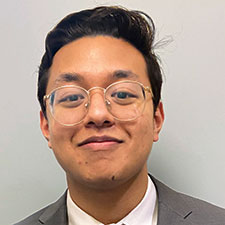
Shrestha, a rising senior majoring in economics at Fordham College at Rose Hill and a member of the University’s Social Innovation Collaboratory, reached out to friends he thought might be interested in helping small businesses.
Diontay Santiago, then a senior majoring in marketing at the Gabelli School of Business, was one of those who answered the call. In June 2020, they launched the Fordham Business Development Collaboratory. The student-run group, comprising more than 70 members, is split into teams that assist clients with finance, marketing, compliance, technology, and communications. Students offer their advice free of charge, relying on lessons they’ve learned in classes. They also conduct research, develop industry reports, and create case studies and videos for Bronx businesses.
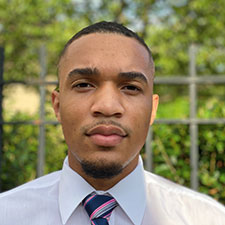
For Santiago, who graduated from Fordham in May and had served as president of ASILI, the Black Student Alliance, the group has been a way to lift up the borough he has called home his whole life. “Doing this sort of thing weds the school to its actual geographic location and allows it to give back to the community it’s inhabited for the last two centuries or so. So when Rich presented me with the opportunity to work with him, I jumped at it.”
The group’s clients have included restaurants, nonprofits, a software company, and an insurance firm. In addition to word-of mouth and its website (fordhambdc.org), the group has connected with clients through the South Bronx Overall Economic Development Corporation.
Sadibou Sylla, the interim director of Fordham’s Social Innovation Collaboratory and an adjunct professor at the Gabelli School, said that all who contribute to the group personify what it means to be a “changemaker.”
“They understand that it is only in serving all that we serve ourselves,” he said, “and that business is nothing but an instrument for helping society.”
Shrestha is optimistic that the group will live on long after he and his classmates graduate.
“This is an opportunity to gain an understanding of the community you’re in, and how we can be a better part of it and better neighbors,” he said. “I think a lot of students are starting to realize how important that is.”
—Patrick Verel, GSAS ’15
Do you know a Fordham “Changemaker”?
Who are the unsung Rams working to foster collaboration and change in your community? Tell us about the people whose stories you’d like us to share. Write to us at [email protected].
“When we started, we wanted to build a structure where we could theoretically put ourselves out of business in the communities [where] we operate,” Stepanian explains. “We want to make sure that there’s going to be no need for us in 30 to 40 years if the community itself can take care of these needs.”
Based on Long Island, Community Solidarity rescues food from being wasted and distributes it to people at food shares across four locations on Long Island and one in Bedford-Stuyvesant, Brooklyn. Each area, he says, is at risk of being a “food desert,” a neighborhood with limited access to fresh, nutritious, affordable food.
Stepanian knew he wanted to focus on helping local communities after graduating from Fordham. As an undergraduate, he studied history and political science, and an internship at the United Nations and a stint working at the American Civil Liberties Union gave him perspective on the benefits and challenges within the intergovernmental and nonprofit sectors. Shortly after college, he and his friends decided to start a Food Not Bombs chapter on Long Island, setting up a food distribution table on occasional weekends.
Before long, he says, he realized he needed to create a more sustainable structure to keep it going. Community Solidarity, with its 501(c)3 nonprofit status, was born out of this realization, although Stepanian notes that a non-hierarchical structure was important from the outset.
“When we decided to become a nonprofit, we said we wanted no lines of demarcation between who can volunteer and who can get food,” he says. “We wanted to make it so you wouldn’t be able to tell if someone’s volunteering or in need or both.”
Community Solidarity’s emphasis on rescuing food waste while feeding neighbors sets it apart from many other hunger relief organizations. In a 2018 TEDxNYU talk, Stepanian talked about what he called “the myth of scarcity,” and how a communal response can address hunger while creating a deeper sense of belonging among neighbors.
“We’re also trying to raise awareness by saying that we will, in 10 years, be the largest hunger relief organization in the country, and we’re doing it for a thousandth of the price that the food banks are doing it, all because of this waste,” Stepanian says. “This is how abundant that system of waste is. We want to make it eye-opening for people.”
Can you talk about Community Solidarity’s emphasis on food waste and rescuing food?
I can go to a typical supermarket and they’re going to be wasting 3,000 to 4,000 pounds of groceries a day. Where we operate on Long Island, there are about 27 million pounds of food that get wasted every single night, and there are about 182,000 people who are going hungry on Long Island every night.
We rescue food waste because it’s common sense—it’s cheap to do it. But on a more philosophical level, on a more economic level, this is why people in our communities are struggling. We see it as a fundamental problem in our system that’s making people in our community poor and hurting people overseas and also destroying our environment by producing large quantities of stuff that we don’t need, which is adding to greenhouse gas emissions and the destruction of natural resources. We’re trying to rescue a small portion of that waste and repurpose it for something good, like feeding our neighbors, but also to expose the problem.
What’s the process for getting the food you distribute?
We go to supermarkets or go to farms, and we ask if they’d work with us in rescuing their food waste. Here’s where the problem comes in. If a supermarket throws out the food, it’s a tax write-off: no questions asked, no lawyers, no accountants needed. They just get their money, which is great for the supermarket. It’s the same thing as selling it. If they donate the food to us, then there are receipts that we have to provide, there are lawyers, there are accountants at the end of the year, there are tax forms. It’s actually a little bit more difficult to donate food than just throw it out. That’s why there’s so much food being thrown out in this country.
When we go to a store, we pitch the idea that our volunteers are trained in this. We know how to work with the store, and we say we can find ways of saving you money by saving your employees’ time. When a store throws out its milk, they actually have to open each [container] and pour it down the drain and then they take the cardboard and put it together and they ship it back to the company in order to get that tax-deductible rebate. We go through the store and we show how we’re going to make it cost-effective for them and how we’re going to get out of the way, not be a nuisance and make sure everything’s been cleaned effectively.
Stores, after they see that and start working with us, they love it. Some of the stores we work with, they have donation areas now. And some of [their] employees come down to our distributions and they volunteer. They might also get food for their families because their paychecks might not be enough to actually pay for food and where they’re living. There’s a solidarity in that, where people want to help out. Some of these employees will say, “Oh, I’m going to go the extra mile,” and make sure it doesn’t get wasted because they see where it’s going.
The sense of community over charity has a lot of overlap with the principles behind mutual aid groups. Were you already engaged with the idea of mutual aid when you started Community Solidarity?
We always had our roots in mutual aid. That kind of goes back to Food Not Bombs. Food Not Bombs has sort of an anarchistic structure, where the idea is anyone can participate. That’s also the foundation of mutual aid. The way I like to envision it is these are principles we need to strive for. If you truly believe food is a right, that food is not mine to give. I think that’s the big difference between mutual aid and charity. There has to be an understanding that basic necessities like water or food, no one should go without [those], especially since there’s such an abundance of them. If somebody in your community needs food, you always want to be there for them. You always want to stand with them and stand up for that right to food. It’s important for people to know that their neighbors are there for them on those hard days. I think we’re all really craving that.
And why vegetarian groceries and vegan meals?
I’m not going to speak for all our volunteers, because the vast majority of our volunteers are not vegan or even vegetarian … [but] we want to show compassion to people coming to us [and] to the Earth and the animals involved in agricultural systems.
It is [also] safer handling these foods than it would be with raw meat. A lot of what we rescue is done with our volunteers’ vehicles. We’ll pick something up and within two or three hours, it’s handed to somebody else. On a hot, sunny day, two or three hours in a trunk, if you had meat, there’s a chance of spoilage. That’s why we don’t distribute meat. If we get non-vegetarian items [donated], what we do is we package it up and bring it to another soup kitchen or pantry that could use it. Right now, we’re supplying about 70 soup kitchens and food pantries across New York City and Long Island. The whole point’s just getting the food out there for people who need it.
This past year has obviously been a challenging one in a lot of ways, including a major increase in food insecurity and hunger. Can you talk about the increased need that you’ve seen and also what kind of challenges COVID-19 has created for you logistically?
It’s been something we never saw happening, the kind of changes we’ve had to make. I think at the end of 2019, we were helping about 5,700 families in a week. Right now, we’re helping a little bit more than 15,000 in a week. When I say helping, at our distributions, you get an entire week’s supply of food for every member of the family. The numbers have gone up drastically, more than threefold. At the same [time], we’ve had to incorporate social distancing.
Before the pandemic, our distributions looked pretty similar to a giant free supermarket or a farmers market, where we’d have areas for fresh produce and baked goods and dried goods and clothing. And you could walk around. There’d be hundreds of people and they’d all be congregating, and it was very crowded. It kind of [had] a festival feeling. It was fun. But obviously you can’t have that in the middle of the pandemic.
We [now] have a walk-up line that’s socially distanced. We break it down by age, so anyone who’s a senior citizen will automatically be served whenever they get there. And then everybody else will be served in the order they get there. We also have drive-through lines. And the drive-through lines are probably the thing that grew the most as the pandemic started to get worse. People with vehicles, we encourage them to stay in their car to keep them safe, to keep our volunteers safe. Everyone’s wearing PPE: gloves, masks, face shields, and everything like that. We offer putting the box on a table and we step back and then you can grab the box and you can go. Or you can come in a car and pop your trunk and it goes directly in your trunk. There are families with their kids in the car at that time that have been on line for six, seven hours. It’s beautiful to see the community coming together to make sure everyone gets food, but it’s also heartbreaking to see that there’s this much need out there.
How do you see Community Solidarity growing from here?
A lot of people keep asking us when we’re leaving southern New York and going to other areas. Our plan is, actually, we want to get to a point where we fix most of the problem in terms of food access out here on Long Island. Going back to that 182,000 number, that’s how many people go hungry every single night in Nassau and Suffolk counties, and we’re reaching 15,000 of them, which is not that many all in all. But considering that we were reaching 5,700 a year before that and 3,000 a year before that, obviously we’re on a trajectory where we could grow, and we want to see how far we can take that growth.
Personally, I don’t want to run a nonprofit that’s all across the country rescuing food and managing all this, because I don’t actually think that is sustainable in the long run. We want to make these tools available to any organization that wants to use them and copy our model. We would love for soup kitchens or food banks anywhere in the country to start copying the way that we’re doing things if they find it more effective. I think the best way of showing them it’s more effective is by literally solving the problem in these communities.
How does your experience at Fordham connect to the work you’re doing?
The [Jesuit] idea of community and working with one another and having hope and striving for something that might not be there yet, that’s something that I find really beautiful. I think it’s something that Fordham gave me that I hold and try to put into practice every single day.
For a list of Community Solidarity’s food share locations and schedule, visit the locations page on their website.
Interview conducted, edited, and condensed by Adam Kaufman, FCLC ’08.
]]>